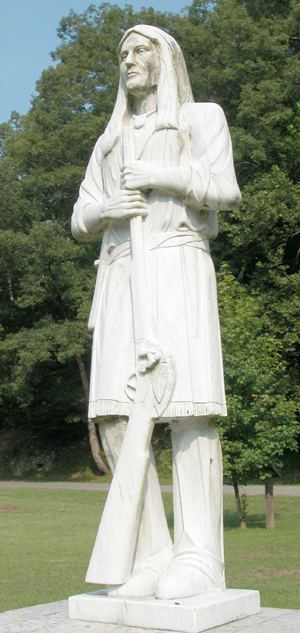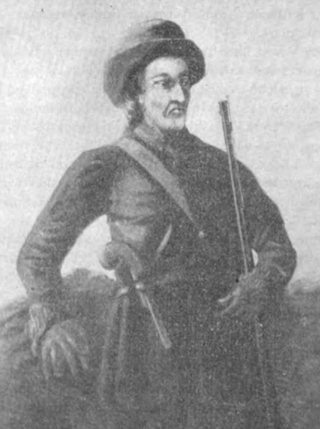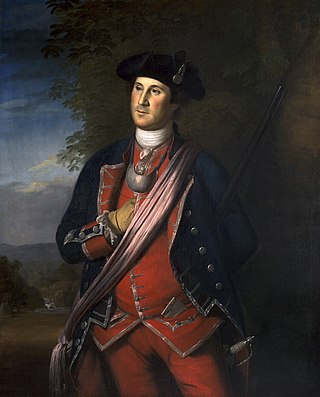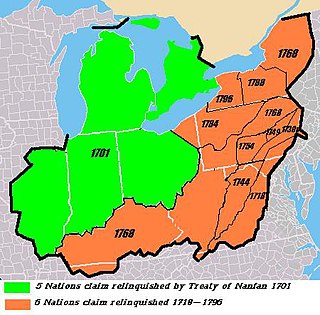
Glasgow is a town in Rockbridge County, Virginia, United States, at the confluence of the James and Maury Rivers. The population was 1,133 at the 2010 census.

Logan the Orator was a Cayuga orator and war leader born of one of the Six Nations of the Iroquois Confederacy. After his 1760s move to the Ohio Country, he became affiliated with the Mingo, a tribe formed from Seneca, Cayuga, Lenape and other remnant peoples. He took revenge for family members killed by Virginian Long knives in 1774 in what is known as the Yellow Creek Massacre. His actions against settlers on the frontier helped spark Dunmore's War later that year.

Lord Dunmore's War, also known as Dunmore's War, was a brief conflict in fall 1774 between the British Colony of Virginia and the Shawnee and Mingo in the trans-Appalachian region of the colony south of the Ohio River. Broadly, the war included events between May and Oct., 1774. The governor of Virginia during the conflict was John Murray, 4th Earl of Dunmore, who in May, 1774, asked the House of Burgesses to declare a state of war with the Indians and call out the Virginia militia.

The western theater of the American Revolutionary War (1775–1783) was the area of conflict west of the Appalachian Mountains, the region which became the Northwest Territory of the United States as well as what would become the states of Kentucky, Tennessee, Missouri, and Spanish Louisiana. The western war was fought between American Indians with their British allies in Detroit, and American settlers south and east of the Ohio River, and also the Spanish as allies of the latter.

Simon Girty was an American-born frontiersman, soldier and interpreter from Harrisburg, Pennsylvania who served as a liaison between the British and their Indian allies during the American Revolutionary War. He was portrayed as a villain, and was also featured this way in 19th- and early 20th-century fiction from the United States. As children, Girty and his brothers were taken captive in Pennsylvania in a Seneca raid and adopted. He lived with the Seneca for seven years and became fully assimilated, preferring their culture. He was returned to his birth family but retained a sympathy for the Indians.

The Virginia militia is an armed force composed of all citizens of the Commonwealth of Virginia capable of bearing arms. The Virginia militia was established in 1607 as part of the English militia system. Militia service in Virginia was compulsory for all free males. The main purpose of the Crown's militia was to repel invasions and insurrections and to enforce the laws of the colony.

Shamokin was a multi-ethnic Native American trading village on the Susquehanna River, located partially within the limits of the modern cities of Sunbury and Shamokin Dam, Pennsylvania. It should not be confused with present-day Shamokin, Pennsylvania, located to the east. The village was the focus of missionary efforts, and then was the staging area for raids on English settlements in Pennsylvania during the French and Indian War. It was burned and abandoned by the Lenape in May, 1756. A few months later, Fort Augusta was constructed on the site of the village.
Andrew Montour, also known as Sattelihu, Eghnisara, and Henry, was an important mixed interpreter and negotiator in the Virginia and Pennsylvania backcountry in the latter half of the 18th century. He was of Oneida and Algonquin ancestry, with a French grandfather. Historian James Merrell estimated his birth year as 1720. Likely born in his mother's village of Otstonwakin, he later led the village in the 18th century before settling further west.

Lochry's Defeat, also known as the Lochry massacre, was a battle fought on August 24, 1781, near present-day Aurora, Indiana, in the United States. The battle was part of the American Revolutionary War (1775–1783), which began as a conflict between Great Britain and the Thirteen Colonies before spreading to the western frontier, where American Indians entered the war as British allies. The battle was short and decisive: about one hundred Indians of local tribes led by Joseph Brant, a Mohawk military leader who was temporarily in the west, ambushed a similar number of Pennsylvania militiamen led by Archibald Lochry. Brant and his men killed or captured all of the Pennsylvanians without suffering any casualties.

The Conrad Weiser Homestead was the home of Johann Conrad Weiser, who enlisted the Iroquois on the British side in the French and Indian War. The home is located near Womelsdorf, Berks County, Pennsylvania in the United States. A designated National Historic Landmark, it is currently administered as a historic house museum by the Pennsylvania Historical and Museum Commission. The historic site was established in 1923 to preserve an example of a colonial homestead and to honor Weiser, an important figure in the settlement of the colonial frontier.

Conrad Weiser, born Johann Conrad Weiser, Jr., was a Pennsylvania Dutch (German) pioneer who served as an interpreter and diplomat between the Pennsylvania Colony and Native American nations. Primarily a farmer, he also worked as a tanner, and later served as a soldier and judge. He lived part of the time for six years at Ephrata Cloister, a Protestant monastic community in Lancaster County.

Shikellamy, also spelled Shickellamy and also known as Swatana, was an Oneida chief and overseer for the Iroquois confederacy. In his position as chief and overseer, Shikellamy served as a supervisor for the Six Nations, overseeing the Shawnee and Lenape tribes in central Pennsylvania along the Susquehanna River and protecting the southern border of the Iroquois Confederacy. While his birth date is not known, his first recorded historical appearance was in Philadelphia in 1728. In 1728 he was living in a Shawnee village in Pennsylvania near modern Milton, and moved in 1742 to the village of Shamokin, modern day Sunbury, at the confluence of the West and North Branches of the Susquehanna. Shikellamy was an important figure in the early history of the Province of Pennsylvania and served as a go-between for the colonial government in Philadelphia and the Iroquois chiefs in Onondaga. He welcomed Conrad Weiser to Shamokin and served as Weiser's guide on his journeys into the frontier of Pennsylvania and New York.

The Six Nations land cessions were a series of land cessions by the Haudenosaunee and Lenape which ceded large amounts of land, including both recently conquered territories acquired from other indigenous peoples in the Beaver Wars, and ancestral lands to the Thirteen Colonies and the United States. The land ceded covered, partially or in the entire, the U.S. states of New York, Pennsylvania, Maryland, Virginia, West Virginia, Kentucky, Ohio, Tennessee and North Carolina. They were bordered to the west by the Algonquian lands in the Ohio Country, Cherokee lands to the south, and Muscogee and Choctaw lands to the southeast.
John Peter Salling, born Johan Peter Saling and sometimes referred to as John Peter Salley, Sayling, Sallings, and Sallee, was a German explorer known for being among the first Europeans to visit parts of Virginia, West Virginia and Kentucky. He was imprisoned by the French in New Orleans on charges of spying and escaped together with another prisoner, taking eight months to finally reach his home in Virginia. His detailed journal describing his journeys of exploration was lost twice, and each time Salling was able to reconstruct it from memory. Salling's journal was used as a source in the creation of early maps of Virginia and eastern North America.
Meshemethequater also known as Big Hominy, Great Huminy, Misemeathaquatha, Missemediqueety, or Big Hannoana was a Pekowi Shawnee chief from western Pennsylvania. Although he was a respected warrior, he is best known for participating in peace conferences that prevented war between English settlers and the Shawnees. In 1745 he joined Peter Chartier and other Shawnees who chose loyalty to New France, but after three years he returned to Pennsylvania and apologized. His date and place of death are unknown.
Kakowatcheky, also known as Kakowatchiky, Cachawatsiky, Kakowatchy, or Kakowatchey, was a Pekowi Shawnee chief believed to be among the first to bring Shawnee people into Pennsylvania. For about fifty years he and the Shawnees lived together with European colonists in Pennsylvania until the mid-1740s when many Shawnees and other Native Americans migrated to the Ohio River Valley.
Sassoonan or Allumapees was a Lenni Lenape chief who lived in Pennsylvania in the late 17th and early 18th century. He was known for his negotiations with the Provincial government of Pennsylvania in several land purchases. He was a respected leader until political intrigue and migration of the Lenape into the Ohio Country diminished his influence. During his final years he became dependent on alcohol and died in Shamokin in 1747. After his death the Lenape were without a chief until 1752, when the Iroquois half-king Tanacharison appointed Shingas to represent them at the Logstown Treaty conference. He was a son of Tamanend, also known as "Tammany," a well-respected Lenape sachem known as a lover of peace and friendship.
Pisquetomen was a Lenape chief who acted as interpreter and negotiator for the Lenape in dealings with the Provincial government of Pennsylvania during the mid-eighteenth century. After being rejected in his bid to succeed his uncle Sassoonan as Lenape chief, Pisquetomen joined Shingas and Captain Jacobs in a series of deadly attacks on Pennsylvania settlements at the beginning of the French and Indian War. He eventually participated in peace negotiations that led to the Treaty of Easton in 1758, and is believed to have died in 1762.
James Lynn Patton, was a merchant, pioneer frontiersman, and soldier who settled parts of Virginia's Shenandoah Valley. Between his immigration to Virginia in 1740, and his death there in 1755, he was a prominent figure in the exploration, settlement, governance, and military leadership of the colony. Patton held such Augusta County offices as Justice of the Peace, Colonel of Militia and Chief Commander of the Augusta County Militia, County Lieutenant, President of the Augusta Court, commissioner of the Tinkling Spring congregation, county coroner, county escheator, collector of duties on furs and skins, and County Sheriff. He also was President of the Augusta Parish Vestry and a member of the Virginia House of Burgesses. He was present at three important treaty conferences with Iroquois and Cherokee leaders. Patton was killed by Shawnee warriors in July 1755.
John Buchanan was a colonial Virginia landowner, magistrate, colonel in the Virginia Militia, deputy surveyor under Thomas Lewis, and Sheriff of Augusta County, Virginia. As a surveyor, Buchanan was able to locate and purchase some of the most desirable plots of land in western Virginia and quickly became wealthy and politically influential. As magistrate, sheriff and a colonel the Augusta County Militia, he was already well-connected when his father-in-law Colonel James Patton was killed in 1755. Buchanan had replaced Patton in several key roles by the time of his own death in 1769.













